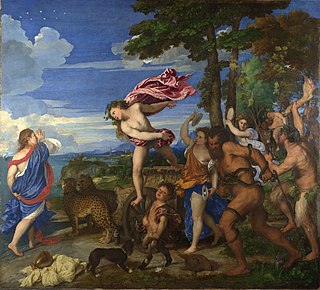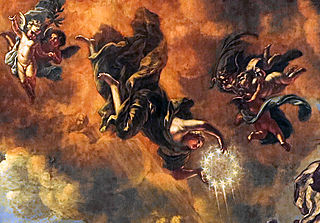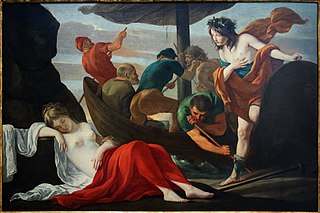
Ariadne was a Cretan princess in Greek mythology. She was mostly associated with mazes and labyrinths because of her involvement in the myths of the Minotaur and Theseus. She is best known for having helped Theseus escape the Minotaur but being abandoned by him on the island of Naxos; subsequently, she became the wife of Dionysus.
Bacchus is the Roman name for Dionysus, the god of wine and intoxication.

Albert Charles Paul Marie Roussel was a French composer. He spent seven years as a midshipman, turned to music as an adult, and became one of the most prominent French composers of the interwar period. His early works were strongly influenced by the impressionism of Debussy and Ravel, while he later turned toward neoclassicism.

Ariadne auf Naxos, Op. 60, is a 1912 opera by Richard Strauss with a German libretto by Hugo von Hofmannsthal. The opera's unusual combination of elements of low commedia dell'arte with those of high opera seria points up one of the work's principal themes: the competition between high and low art for the public's attention.

In Greek mythology and religion, the thiasus, was the ecstatic retinue of Dionysus, often pictured as inebriated revelers. Many of the myths of Dionysus are connected with his arrival in the form of a procession. The grandest such version was his triumphant return from "India", which influenced symbolic conceptions of the Roman triumph and was narrated in rapturous detail in Nonnus' Dionysiaca. In this procession, Dionysus rides a chariot, often drawn by big cats such as tigers, leopards, or lions, or alternatively elephants or centaurs.

Catullus 64 is an epyllion or "little epic" poem written by Latin poet Catullus. Catullus' longest poem, it retains his famed linguistic witticisms while employing an appropriately epic tone.

The Loves of the Gods is a monumental fresco cycle, completed by the Bolognese artist Annibale Carracci and his studio, in the Farnese Gallery which is located in the west wing of the Palazzo Farnese, now the French Embassy, in Rome. The frescoes were greatly admired at the time, and were later considered to reflect a significant change in painting style away from sixteenth century Mannerism in anticipation of the development of Baroque and Classicism in Rome during the seventeenth century.
Ariadne was a figure in Greek mythology.

Bacchus and Ariadne (1522–1523) is an oil painting by Titian. It is one of a cycle of paintings on mythological subjects produced for Alfonso I d'Este, Duke of Ferrara, for the Camerino d'Alabastro – a private room in his palazzo in Ferrara decorated with paintings based on classical texts. An advance payment was given to Raphael, who originally held the commission for the subject of a Triumph of Bacchus. At the time of Raphael's death in 1520, only a preliminary drawing was completed and the commission was then handed to Titian. In the case of Bacchus and Ariadne, the subject matter was derived from the Roman poets Catullus and Ovid.

Bacchus is an opera in four acts by Jules Massenet to a French libretto by Catulle Mendès after Greek mythology. It was first performed at the Palais Garnier in Paris on 5 May 1909.

The Crown of Immortality is a literary and religious metaphor traditionally represented in art first as a laurel wreath and later as a symbolic circle of stars. The Crown appears in a number of Baroque iconographic and allegoric works of art to indicate the wearer's immortality.

Ariadne in Naxos is a painting by the Le Nain brothers, dating approximately 1635, that is part of the collection of French paintings in Orléans's Fine Arts museum. It is a 102*152 cm oil on canvas.
Bacchus and Ariadne, Op. 43 is a ballet score by the French composer Albert Roussel written in 1930.
Hero and Leander is a poem by Leigh Hunt written and published in 1819. The result of three years of work, the poem tells the Greek myth of Hero and Leander, two lovers, and the story of their forlorn fate. Hunt began working on the poem during the summer of 1816, arousing the interest of the publisher John Taylor, and despite repeated delays to allow Hunt to deal with other commitments the poem was finished and published in a collection 1819. Dealing with themes of love and its attempt to conquer nature, the poem does not contain the political message that many of Hunt's works around that time do. The collection was well received by contemporary critics, who remarked on its sentiment and delicacy, while more modern writers such as Edmund Blunden have criticised the flow of its narrative.
Bacchus and Ariadne is a poem by Leigh Hunt written and published in 1819. The result of three years of work, the poem tells the Greek myth of Hero and Leander, two lovers, and the story of their forlorn fate. Hunt began working on the poem during the summer of 1816, arousing the interest of the publisher John Taylor, and despite repeated delays to allow Hunt to deal with other commitments the poem was finished and published in a collection 1819. Hunt later claimed in a poem about Bacchus and Ariadne that he was seeking to humanise myths and make them more understandable to the common people. The collection was well received by contemporary critics and poets, including Thomas Carlyle, while more modern writers such as Edmund Blunden have criticised the flow of its narrative.

The Sleeping Ariadne, housed in the Vatican Museums in Vatican City, is a Roman Hadrianic copy of a Hellenistic sculpture of the Pergamene school of the 2nd century BC, and is one of the most renowned sculptures of Antiquity. The reclining figure in a chiton bound under her breasts half lies, half sits, her extended legs crossed at the calves, her head pillowed on her left arm, her right thrown over her head. Other Roman copies of this model exist: one, the "Wilton House Ariadne", is substantially unrestored, while another, the "Medici Ariadne" found in Rome, has been "seriously reworked in modern times", according to Brunilde Sismondo Ridgway. Two surviving statuettes attest to a Roman trade in reductions of this familiar figure. A variant Sleeping Ariadne is in the Prado Museum, Madrid. A later Roman variant found in the Villa Borghese gardens, Rome, is at the Louvre Museum.

The Bacchanal of the Andrians or The Andrians is an oil painting by Titian. It is signed "TICIANUS F.[aciebat]" and is dated to 1523–1526.
Metamorphoses (Transformations) is a Latin narrative poem by the Roman poet Ovid, considered his magnum opus. Comprising fifteen books and over 250 myths, the poem chronicles the history of the world from its creation to the deification of Julius Caesar within a loose mythico-historical framework. Although meeting the criteria for an epic, the poem defies simple genre classification by its use of varying themes and tones.

Bacchus, Venus and Ariadne is an oil painting executed in Venice in 1576–77 by the Italian painter Jacopo Tintoretto which hangs in the Sala dell'Anticollegio at the Doge's Palace (the Pallazzo Ducale} in Venice. It is one of four almost square paintings on mythological subjects in the same room which were commissioned to celebrate the government of Doge Girolamo Priuli.

Young Couple is a c.1505-1510 Carrara marble relief sculpture by Tullio Lombardo, now in the Kunsthistorisches Museum in Vienna. It was previously known as Bacchus and Ariadne, whilst a recent study by Claudia Kryza-Gersch has suggested the alternative title of The Singing Poet and His Lover.













